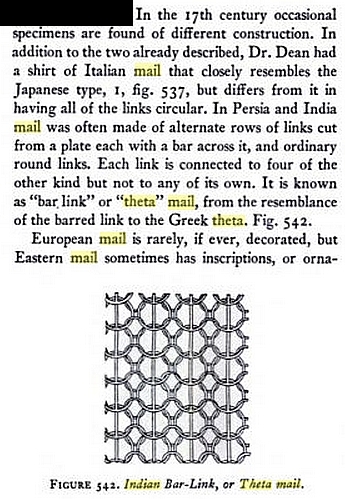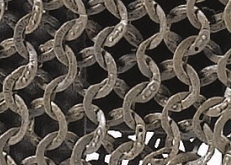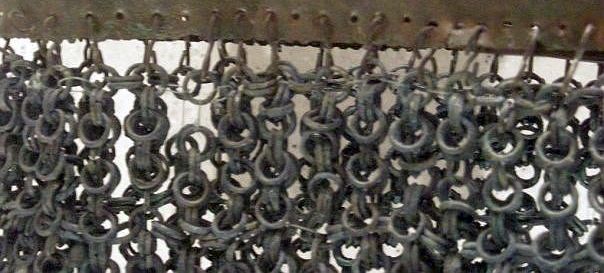There's apparently one very interesting piece of mail in Krakow's national museum, sadly can find only one not very good picture:
[ Linked Image ]
Have anyone seen similar rings before?
So-called "theta" mail. Almost certainly a sign of Indian origin,
[ Linked Image ]
[ Linked Image ]
| Mart Shearer wrote: |
| Forgive my imprecision in language, regarding "Bulgarian" vs. "in Bulgaria". In the AA thread, it is stated this is all riveted construction. My limited exposure to Turkish and Persian mail has always shown demi-riveted construction. Perhaps you have an example of a Turkic or Persian mail coif which is shaped in a similar manner for comparison? |
Mart, there are examples of what is said to be Indo-Persian mail that are completely riveted, the problem with this is there is no way of knowing if these examples are just European mail which have found their way to an Indo-Persian country or if they were actually manufactured there. As far a coifs go I have never seen an Indo-Persian coif that resembles the one in Bulgaria, then again I have not seen a European coif that closely resembles it either, the closest I have seen are khevsur coifs. If I had to guess i would say it is a European coif, the all riveted construction, the lack of a metal top plate, the general design are things not seen in the existing Indo-Persian examples that I know about.
The theta mail (at least in pictures, I haven't gotten to see any in person) doesn't look to be denser than 'regular' mail. Is its purpose decorative, just different, or does it have some sort of special significance?
There is a section on theta, or bar mail, in the Mail Unchained article.
| Mart Shearer wrote: |
| So-called "theta" mail. Almost certainly a sign of Indian origin |
Mart, according to Stone it was used in Persia as well as India.

| Kai Lawson wrote: |
| The theta mail (at least in pictures, I haven't gotten to see any in person) doesn't look to be denser than 'regular' mail. Is its purpose decorative, just different, or does it have some sort of special significance? |
Kai, from what I can see theta link mail was just another way of making solid links, from the few images available it seems to take the place of a solid link between the riveted links.
[ Linked Image ]
[ Linked Image ]
[ Linked Image ]
You hear that the rivet is the weak part of the link, this triple riveted mail may have solved that problem, it looks very complete for its age.
Mamluk (Egypt) mail shirt, 15th c, triple riveted and solid links, each stamped with three sets of inscriptions, the reverse decorated with interlacing scrolls, lower skirt composed of single riveted links, each stamped with two concentric circles,118cm, inscribed on triple riveted link and main body solid links: 'Amir al-kabir misr sultan 'aqib khyar' Interspersed solid links: al-'izz fi'l-ta'a al-ghina fi'l-qana'a 'Power is in obedience" and "wealth is in contentment'.
[ Linked Image ]
Mamluk (Egypt) mail shirt, 15th c, triple riveted and solid links, each stamped with three sets of inscriptions, the reverse decorated with interlacing scrolls, lower skirt composed of single riveted links, each stamped with two concentric circles,118cm, inscribed on triple riveted link and main body solid links: 'Amir al-kabir misr sultan 'aqib khyar' Interspersed solid links: al-'izz fi'l-ta'a al-ghina fi'l-qana'a 'Power is in obedience" and "wealth is in contentment'.
[ Linked Image ]
Those triple links look enormous--do you have any measurements? Also, is the rivet structure round-wedge-round, or are all three wedge rivets, looking like this: V A V (the 'A' is the central rivet, facing opposite to the other two rivets)?
Len Parker brought this "triple-riveted" example on p.2 of a previous thread. Dan, Len, and I batted around a few ideas. I've never seen a failed rivet in the center in the photographs, though the round rivets are occasionally missing.
http://www.myArmoury.com/talk/viewtopic.php?t...p;start=44
The supposed third wedge rivet might be part of the coining that makes the inscription, or it might be a rectangular, rather than wedge rivet like this Iranian example in the Met (with missing rivet).
http://images.metmuseum.org/CRDImages/aa/original/DP147152.jpg
Double pin rivets aren't unknown in Turkish and Iranian mail.
http://www.metmuseum.org/collections/search-the-collections/32094
http://www.myArmoury.com/talk/viewtopic.php?t...p;start=44
The supposed third wedge rivet might be part of the coining that makes the inscription, or it might be a rectangular, rather than wedge rivet like this Iranian example in the Met (with missing rivet).
http://images.metmuseum.org/CRDImages/aa/original/DP147152.jpg
Double pin rivets aren't unknown in Turkish and Iranian mail.
http://www.metmuseum.org/collections/search-the-collections/32094
| Kai Lawson wrote: |
| Those triple links look enormous--do you have any measurements? Also, is the rivet structure round-wedge-round, or are all three wedge rivets, looking like this: V A V (the 'A' is the central rivet, facing opposite to the other two rivets)? |
Kai, unfortunately no measurements, it looks to me like the outer rivets are round and the center rivet is more of an oval shape rather than wedge shaped.
This first image shows a similar shaped copper rivet from another armor.
[ Linked Image ]
[ Linked Image ]
[ Linked Image ]
Neckline showing the inside of the links.
[ Linked Image ]
Neckline showing the outside of the links.
[ Linked Image ]
| Quote: |
| This armour belongs to a known group of inscribed shirts found in some of the major collections around the world. The talismanic nature of these shirts is shown in the inscriptions stamped on each link, either a specific benediction or the names of The Prophet Muhammad and his family. The purpose is clearly to protect the wearer both physically and spiritually from any harm in battle. A small number of these shirts have survived and are now held in The Hermitage, St. Petersburg, the Nasser D. Khalili Collection, London, the Kremlin, Moscow, The Metropolitan Museum of Art, New York, the Musée de l'armée, Paris, the Royal Armouries, Leeds, the Topkapi Saray, Istanbul, as well as some important private collections.
The exact origins of this group have never been satisfactorily identified, and Persia has also been suggested as a place of manufacture in a series of articles written between 1897 and 1918 (specifically relating to the pieces in the Russian collections and one in a private German Colleciton). However, in 1934, Hans Stöcklein argued that the discussed examples were more likely to be Mamluk: "Up to the present, inscriptions have been found on individual rings only in shirts which...can be definitely identified as Mamluk Egyptian" (Pope and Ackermann 1938-9, p.2560). This shirt, unknown to previous researchers, offers a good deal of information regarding place of origin. The main body of links specifically names Egypt (Masr), thus proving for the first time that these shirts are Mamluk. The shape of the rivets and the flattened nature of each link also define this particular group of armour. Triple riveting is extrememly rare and a comparable shirt with the same link construction is in The Metropolitan Museum of Art (Inv.31.35.3, see D.G. Alexander, 'Decorated and Inscribed Mail Shirts in the Metropolitan Museum', in Waffen-und Kostumkunde, 1, 1985, pp.29-36, no.5), which also shares the same rolling scroll design as the present example. The non-inscriptive links on this mail shirt can also be paralled with another Mamluk shirt in the Met (no.14.99.28, see ibid., no.6). The nature of this armour, referencing the Sultan of Egypt as well as talismanic benedictions, suggest that it was probably a gift from the Sultan, forming part of the badge of office. Such gifts marking promotion and rank are well-known within Mamluk society, indeed a set of robes for horses, and sometimes a sword, accompanied the appointments of Amirs to Military offices (W. Popper, Egypt and Syria Under the Circassian Sultans 1386-1486, New York, 1977). In its fine condition, complex construction and historically important inscriptions, this is certainly among the rarest examples of a unique group of armour. |
I recall the feeling that the inside view at the neck was not reliable, but was believed by some to be photo-shopped from elsewhere on the shirt..
| Mart Shearer wrote: |
| The supposed third wedge rivet might be part of the coining that makes the inscription, |
It is frustrating that we never get photos of the other side of these links.
Aside from the 'different-ness' and the extra wealth (possibly) implied by the additional rivets, is there any specific point to the additional riveting? Does it noticeably enhance the resistance of the ring to being torn open at the join? I understand that the rivet is not necessarily the weakest point on a link; is the extra riveting done as a form of insurance, status symbolism or some combination of factors?
I see what you mean about the oval shaped central rivet. Does anyone else think that all of them were likely set at the same time with a single tool (a three-rivet pliers, as it were)?
I see what you mean about the oval shaped central rivet. Does anyone else think that all of them were likely set at the same time with a single tool (a three-rivet pliers, as it were)?
Erik reckons that when he tested his links that they don't usually fail at the rivet. If one rivet is enough to prevent the join from failing then I'm not sure what additional rivets would do.
| Kai Lawson wrote: |
| Aside from the 'different-ness' and the extra wealth (possibly) implied by the additional rivets, is there any specific point to the additional riveting? Does it noticeably enhance the resistance of the ring to being torn open at the join? I understand that the rivet is not necessarily the weakest point on a link; is the extra riveting done as a form of insurance, status symbolism or some combination of factors? |
I have not seen any actual battle damage on an authentic mail armor, maybe someone here has an image of some. What I have seen many times are links that have failed at the rivet. Just wearing such a heavy armor puts a lot of stress on the links, it is possible that the double and triple rivets were done for a specific reason such as limiting individual link failure that would be caused from the use of extra large and heavy links and of course you would need the extra wealth necessary to pay for it. It would have been nice to know the measurements of the links or the total weight of the armor but it looks to be substantial.
[ Linked Image ]
Last edited by Eric S on Sun 05 Jan, 2014 8:08 pm; edited 1 time in total
| Mart Shearer wrote: |
| I recall the feeling that the inside view at the neck was not reliable, but was believed by some to be photo-shopped from elsewhere on the shirt.. |
Mart, if you think the neck line images can not be trusted look closely around the left shoulder area, it appears that you can see the reverse side of some random links, if so the front and back are a mirror image of each other.
http://www.sothebys.com/en/auctions/ecatalogu...t.318.html

Last edited by Eric S on Wed 08 Jan, 2014 8:14 am; edited 1 time in total
| Eric S wrote: |
| I have not seen any actual battle damage on an authentic mail armor, maybe someone here has an image of some. What I have seen many times are links that have failed at the rivet. Just wearing such a heavy armor puts a lot of stress on the links, it is possible that the double and triple rivets were done for a specific reason such as limiting individual link failure that would be caused from the use of extra large and heavy links and of course you would need the extra wealth necessary to pay for it. It would have been nice to know the measurements of the links or the total weight of the armor but it looks to be substantial. |
I've seen cuts in mail, but long before the days of digital cameras. David Counts had allowed me to look over one of his new acquisitions some decades ago, and there was a clear, V-shaped gouge near a shoulder which crossed over several links (since turned to a new alignment) which extend about 2"/50mm through about 5 rings in multiple rows. None had been cut through completely, but he concurred that it was the result of a cut.
No idea of the triple riveted mail weight, but the double riveted mail image which you attached is in the Metropolitan Museum of Art, which lists the entire garment at 23 lb. 3 oz./10.52kg. Not unusually heavy IMO.
http://www.metmuseum.org/collections/search-t...2094?img=1
Here's another double riveted shirt in Podolsk, Russia.
http://museum.velizariy.kiev.ua/hmel_obl/kpm/images/kp011.jpg
http://museum.velizariy.kiev.ua/hmel_obl/kpm/images/kp010.jpg
http://museum.velizariy.kiev.ua/hmel_obl/kpm/images/kp009.jpg
I think the doubled rivets were merely an expensive redundancy of systems. It seems common on many mail garments to find at least one rivet which has failed in the course of use and cleaning. The "triple riveted" example shows a number of the rings with one round rivet missing.

With Mac's discussion of mail sleeves, "Otagiri" on Armour Archive provided links to the DHM, so here's their mail items.
http://www.dhm.de/datenbank/dhm.php?seite=6&a...hen=Suchen
http://www.dhm.de/datenbank/dhm.php?seite=6&a...hen=Suchen
| Mart Shearer wrote: |
| With Mac's discussion of mail sleeves, "Otagiri" on Armour Archive provided links to the DHM, so here's their mail items.
http://www.dhm.de/datenbank/dhm.php?seite=6&a...hen=Suchen |
Mart this museums pathetic images are a disappointment, besides being very low quality they put a watermark across all of the images. Blurry images without close ups, they make me want to go there and show them how to photograph items so that people can actually learn something from them.
Here is a good example, a small patch of an unusual form of coiled mail, it has a date range of 1500 - 1700 without any mention of were it may have came from and how did they get that date range?. To me it resembles the example of Etruscan mail that I posted but I think that it is actually an example of a rare Japanese mail.
Just by chance I very recently I edited a photo of a picture taken of an Japanese armor in a Japanese museum (Wakayama Castle). It is only the second known image showing this specific type of Japanese mail, I was able to edit the image and get a close up of the mail, it seems to be the same as this image from the Deutsches Historisches Museum.
Coiled mail from the Deutsches Historisches Museum.


Etruscan mail

Japanese coiled mail from Wakayama Castle.
[ Linked Image ]
[ Linked Image ]
| Eric S wrote: |
|
I have not seen any actual battle damage on an authentic mail armor, maybe someone here has an image of some. What I have seen many times are links that have failed at the rivet. |
Eric,
There is an excellent picture in the "Shiny Shapes" http://www.amazon.com/Shiny-Shapes-Zeughaus-E...3211830987 book which shows where the dense mail of a standard has resisted a heavy thrust. I will try to scan and post the pic later today.
I have also seen an example of damage on a mail sleeve in the Kienbush collection in Philadelphia. In this case, several of the rings have been deformed into long narrow ovals, but none of them had failed.
In general, my impression is that when rings fail at the rivets, it is either because the rivet was badly set in the first place , or because differential corrosion is causing the rivets to loosen and fall out. I think that a well made and well maintained mail ring will deform to a surprising degree before the rivet fails.
Mac
Page 5 of 27
You cannot post new topics in this forumYou cannot reply to topics in this forum
You cannot edit your posts in this forum
You cannot delete your posts in this forum
You cannot vote in polls in this forum
You cannot attach files in this forum
You can download files in this forum
All contents © Copyright 2003-2006 myArmoury.com — All rights reserved
Discussion forums powered by phpBB © The phpBB Group
Switch to the Full-featured Version of the forum
Discussion forums powered by phpBB © The phpBB Group
Switch to the Full-featured Version of the forum